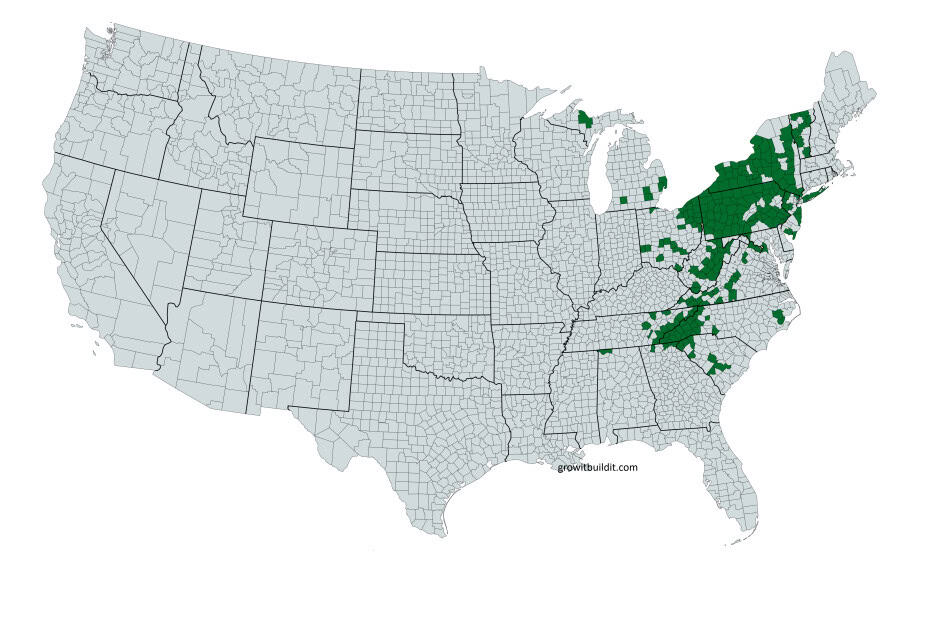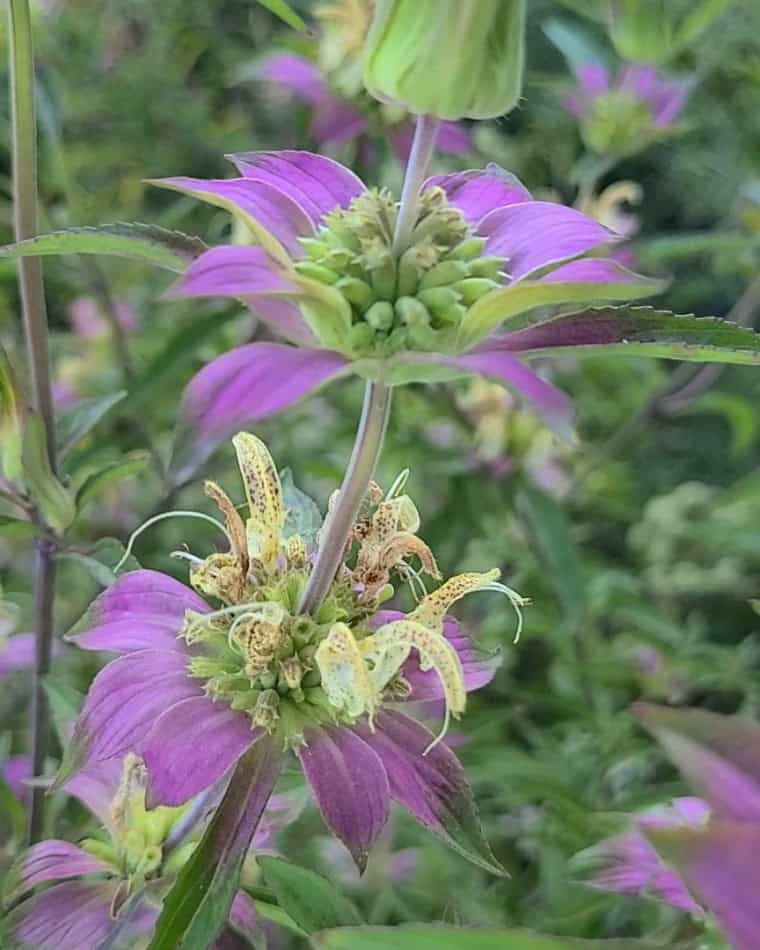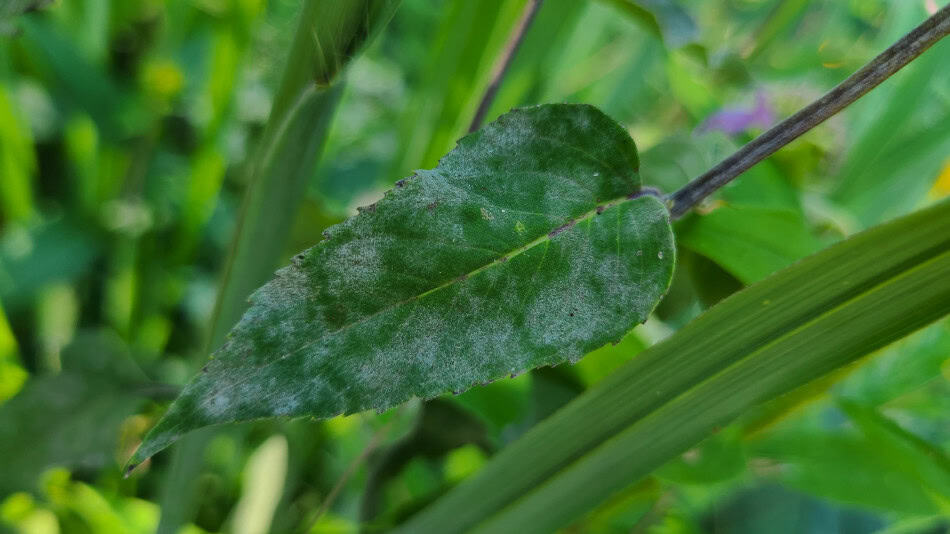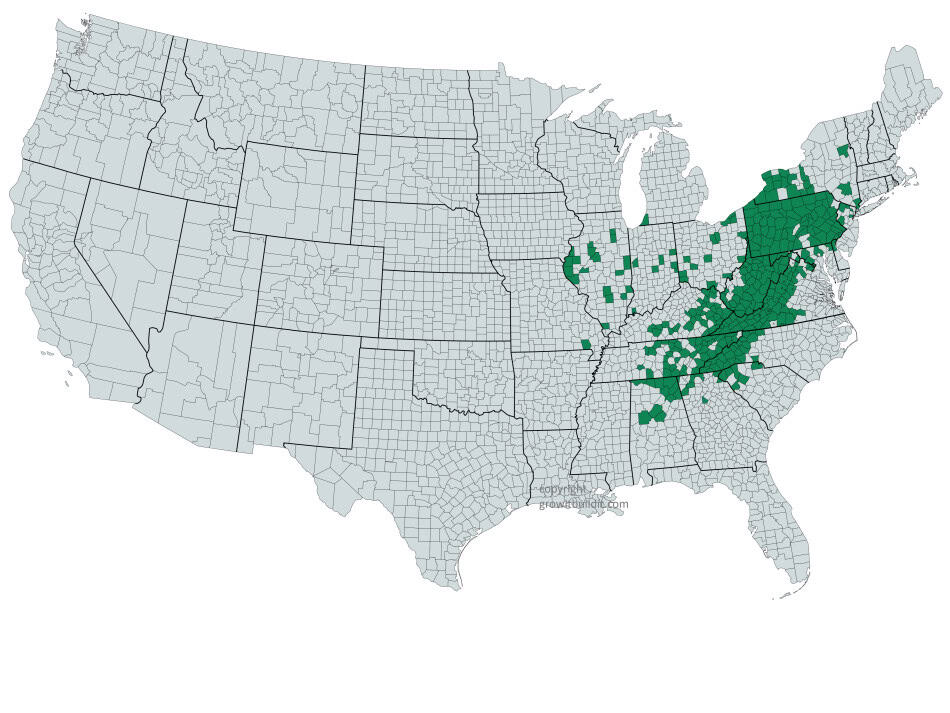Bee Balm is one of the most gorgeous plants you can grow in your garden or yard. But there is a problem. The common name Bee Balm is used interchangeably for several different species, as their flowers share some similar characteristics. So, I will attempt to clarify that for you in this article, which will detail some of the most common types of Bee Balm, as well as provide a brief overview of the plant and their growing conditions.

What is Bee Balm
Bee Balm is a common name for several different plants that belong to the Monarda genus. They all share similar characteristics in their flower structure in that their flowerheads have a ring of flowers that bloom radially from center to outer diameter over the course of several weeks. Each flower has two lips and a tubular calyx, giving it an out-of-this-world appearance. These are some of the most interesting and exotic looking flowers that are native to North America.
Pros of Bee Balm
Beauty
The flowers of all Bee Balms are beautiful. These plants produce one of the most stunning and unique flowerheads of any species native to North America. A strong stand of Bee Balm is a stunning sight that can really increase curb appeal.
Hummingbirds & Wildlife
Bee Balms are known to be particularly attractive to hummingbirds, and most species will reliably draw them in. But beyond Hummingbirds you can be treated to a variety of bees, skippers, butterflies, and even hummingbird-moths depending on what species you grow.
Long Bloom Duration
Bee Balms generally bloom for at least four weeks, and sometimes longer. So for a perennial, this would be considered a very long bloom duration. I grow five different species at my home, and have some Bee Balm blooming from May through September in zone 6/7.
Deer and rabbit resistant
All Bee Balms are members of the mint family. And as such their foliage has a strong aroma that dissuades deer and rabbits from browsing the leaves and flowers. So, bee balms are naturally deer resistant!
Cons of Bee Balm
Spreading by Rhizomes
One characteristic that many (but not all) bee balms have is that they will spread via rhizomes. Now this is mainly a drawback if you’re trying to grow them in a formal, mulched flower bed. But, you can easily pull up the shallow unwanted shoots in early Spring.
Later season appearance
Another common problem of Bee Balms is that the foilage will often look a bit rough late in the season. This can be due to fungal diseases like powder mildew or leaf spot. Or sometimes the plant’s seed heads just look a bit unsightly.
Common Types of Bee Balm
(Click on maps to enlarge)
Bradbury’s Bee Balm (Monarda bradburiana)
One of the shorter Bee Balms is known as Bradbury’s Bee Balm, which is primarily native to the Southern Midwest from Oklahoma to Illinois. A long-lived perennial, this type grows 1-2′ tall blooming lovely lavender flowers in early Spring[1]. It spreads via rhizomes, but if given some space this can easily be controlled by Spring root pruning, or planting in a pot lined with landscape fabric.
This Bee Balm is best suited for part-sun conditions and dry to medium-moisture. It isn’t picky on soil conditions, but it should drain well. I’ve had this growing for several years in locations that receive sun for most of the day, but become shaded in mid-afternoon. One more benefit is that this species is resistant to powdery mildew, and foliage probably looks the best all season.

Scarlet Bee Balm (Monarda didyma)
Probably the most popular Bee Balm, and most commonly referred to as ‘bee balm’, Monarda didyma probably has the longest blooming period of up to two months. This species produces absolutely stunning out-of-this-world red flowers that is probably the single best attractor of humming birds I’ve ever seen. It also attracts butterflies, but very few bees as they cannot reach the nectar. It’s native range is primarily in the Appalachian mountains of the East. 
This species is a perennial that can grow up to 4′ tall in full sun to part-sun, but will greatly benefit from being shaded in the afternoon. This is because it prefers moist to medium-moist conditions, and it is not drought tolerant.

Red Bee Balm mainly spreads via rhizomes, as it just doesn’t seem to produce much seed. And of all the Bee Balms, it probably has the most aggressive rhizomes. But unwanted shoots really are easy to pull in Spring. The chore will take you probably 10 minutes for a typical patch.
Lemon Bee Balm (Monarda citriodora)
A shorter-lived annual to biennial, Lemon Bee Balm is also shorter in stature, only growing up to 30″ tall. The flower structure here is stacked & whorled, meaning they wrap around the stem. And under each whorl are bracts, which resemble leaves and usually produce some interesting color. It’s primary native range in the Southern United States and Northern Mexico. This species is also resistant to powdery mildew.
Lemon Bee Balm does best in full to part-sun, and dry to medium moistures. If you plant this in moist conditions, or too-fertile soil the plant may grow too tall and fall over.

Spotted Bee Balm (Monarda punctata)
A short-lived perennial, or sometimes even an annual, Spotted Bee Balm has just about the most unique flower look of all bee balms. The colors are just out of this world, blending pink, cream, yellow, and greens in such a manner that one could be forgiven thinking this flower belonged in a tropical rainforest!
But ignore those thoughts, as this plant is fully native from New Mexico to Minnesota and east to the Atlantic Ocean. And it will actually do best in dry soils where there is less competition. It does best in full sun, and medium-moist to dry soils that drain very well (more on the sandy side). This is about the last Bee Balm to bloom, and it usually begins in August or September for me in zone 6/7, and lasts about a month. It is very popular with bees and smaller butterflies in this time period.

This species is resistant to powdery mildew, but very late in the season is may flop over and look a bit rough.
White Bee Balm (Monarda clinopodia)
White Bee Balm looks very similar to the aforementioned Red Bee Balm, and also likes similar growing conditions, yet this one is resistant to powdery mildew. But it’s beautiful white flowers attract numerous bees, butterflies, and yes, hummingbirds. You can find this native primarily in the Appalachian mountains from Mississippi to New York.
Now, according to references this plant can allegedly grow up to six feet tall, however I have never seen it go above 2’….so I actually think the references are wrong on this one. But it likes full to part sun, moist to medium-moist conditions and soils that contain some organic matter. It blooms 4-6 weeks in late Spring to early Summer, and really does a great job attracting all manner of pollinators.

Wild Bergamot (Monarda fistulosa)
A taller species, Wild Bergamot can grow up to 4′ tall in optimum conditions of Full sun and medium-moist soils. It is probably the most adaptable of all Bee Balms in that it can tolerate moist to slightly dry conditions, and full or part-sun. A rugged species, it thrives in harsh environments like roadsides. It’s adaptability speaks to it’s wide native range, as it is the most widespread of all Bee Balms.
This species is probably the most popular with pollinators in that it seems to attract the highest number of species. It is incredibly busy when blooming, and does an amazing job attracting bumblebees and large butterflies.

Bee Balm Quick Reference Tables
Characteristics
| Bee Balm Type | Height | Spacing | Bloom color / duration |
|---|---|---|---|
| Bradburys Bee Balm | 1-2′ | 3′ | Lavender, light pink, Purple / 4 weeks |
| Red Bee Balm | 2-4′ | 3′ | Sandy loam to clay |
| Lemon Bee Balm | 12-30″ | 3′ | Any / Well-draining |
| Spotted Bee Balm | 2-4′ | 18-36″ | Sandy to sandy loam – well draining |
| White Bee Balm | 2′-6′ | 1-2′ | Any |
| Wild Bergamot | 3-4′ | 3′ | Any |
Growing conditions
| Bee Balm Type | Sunlight | Soil Moisture | Soil Texture |
|---|---|---|---|
| Bradburys Bee Balm | Full sun to part-sun | Dry to medium | Any / Well-draining |
| Red Bee Balm | Full to part-sun | Moist to medium | Sandy loam to clay |
| Lemon Bee Balm | Full sun | Dry to medium | Any / Well-draining |
| Spotted Bee Balm | Full sun | Dry to medium | Sandy to sandy loam – well draining |
| White Bee Balm | Full to part-sun | Moist to medium | Any |
| Wild Bergamot | Full sun | Dry to medium-moisture | Any |
Is Bee Balm aggressive?
One topic that must be addressed when discussing bee balm is how some species are aggressive and can spread via rhizomes. Rhizomes are underground horizontal stems (some people describe them as roots) that allow a plant to send up new shoots away from the mother plant. This can give some species a well-earned reputation for spreading aggressively.

Pretty much all species within the Monarda genus will spread via rhizomes. The only exception I can say with certainty that does not is Spotted Bee Balm.
But, there are two ways to manage this aggressiveness. The first method is to pull up any unwanted shoots by hand, or using a shovel to root prune each Spring. The second method is more permanent, but has been successful for me, is to plant the plant in a large pot lined with landscape fabric, directly in the ground. I detail this method (with video) here.
Grow and Care for Bee Balm
For caring for Bee Balm, the secret is to match the species with it’s preferred growing conditions. So, Red Bee Balm is not drought tolerant and wouldn’t do well in a sandy-soil slope that is fully exposed to the sun. But it does great in locations that get morning sun and afternoon shade, as these areas don’t dry out.
When a plant is in it’s non-preferred sun or moisture conditions, it will often become stressed. This makes the plant more susceptible to disease, which will make the plant look worse aesthetically.
Wildlife
So, in general all Bee Balms are very attractive to numerous species of bees, butterflies, and hummingbirds. They are among the most productive when it comes to feeding pollinators. Of the five species I grow in my half-acre, all a excellent at attracting bees, butterflies, and skippers…except one.

Scarlet Bee Balm is a bit different from this others in that most bees avoid it, and only the occasional bumblebee will go for it. Even then, it has to tear a hole at the base of the flower to access the nectar, as the tube is just too long. On the flipside though, Scarlet Bee Balm is the best at attracting hummingbirds.
Diseases
There is one disease that many species of Bee Balm are prone to, and that is Powdery Mildew. Powdery Mildew is a fungus that grows in humid and moist environments. And unfortunately, the most popular bee balms, Red Bee Balm and Wild Bergamot are very susceptible and will almost always get it at some point.. But don’t be too alarmed by this – I’ve been growing them for many, many years, and I have never lost a plant to powdery mildew. The effects are purely cosmetic.

If you are inclined to kill off Powdery Mildew though, conventional fungicides are effective. If you would prefer to use natural materials, then spraying milk on the leaves, a baking soda mixture, or even neem oil can be effective.
One other disease that they can get is leaf-spot fungus. Like powdery mildew, this can make the foliage look unsightly, but it will not be fatal to the plant.
Cultivars of Bee Balm
Being such a popular plant, the nursery industry has developed numerous cultivars or varieties of Bee Balm (learn about the differences here). Some of these are hybrids or clones that produce particularly showy blooms, while others have been crossed to make types that will not spread[8].
Some of the best cultivars of Bee Balm:
- Monarda fistulosa ’Claire Grace’, bred for it’s resistance to powdery mildew, and darker, showier purple flowers
- Monarda ‘Violet Queen’, which has great powdery mildew resistance and showy purple flowers
- Monarda ‘Judith’s Fancy Fuchsia’ – a tall red hybrid, it was very showy and resistant to powdery mildew
- Monarda ‘AChall’ (Grand Marshall™), which is a compact hybrid that had good resistance to powdery mildew.
Where to buy Bee Balm
Many nurseries and even big-box stores sell Bee Balm. These will almost always be cultivars though, and not straight species. If you are looking for a straight species, then I strongly suggest you check out a native plant nursery. I have an interactive map below that details nurseries that specialize in natives, organized by state.
Where to buy seeds
We have ordered a variety of native flower seeds from Everwilde Farms, which you can order right from Amazon through our link on our RECOMMENDED PRODUCTS PAGE. (We may earn a small commission when you purchase through our links, at no cost to you. This helps support our website.)
Find more native plants here
References:
[1] – Monarda bradburiana, USDA NRCS.
[2] – Monarda didyma L. Scarlet Beebalm. USDA NRCS.
[3] – Monarda citriodora. USDA NRCS.
[4] – Monarda punctata L. Spotted Beebalm. USDA NRCS.
[5] – Monarda clinopodia L. USDA NRCS.
[6] – Monarda fistulosa L. USDA NRCS.
[7] – Gupta, D. and Sharma, J.N.L. (2005). CHEMICAL CONTROL OF POWDERY MILDEW OF APPLE IN WARMER
CLIMATES OF HIMACHAL PRADESH, INDIA. Acta Hortic. 696, 355-357 DOI: 10.17660/ActaHortic.2005.696.61 https://doi.org/10.17660/ActaHortic.2005.696.61
[8] – Coombs, George. Monarda for the mid-Atlantic region. Mt. Cuba Center, 2016.
Recent Posts
Got a flat wheelbarrow tire? You've come to the right place. I've repaired them multiple times. Whether you rolled it over a nail or the tube just became a bit worn, you can fix it and I will show...
Downy Wood Mint is a perennial wildflower native to Eastern North America[1]. Scientifically known as Blephilia ciliata, it grows 12-30” tall in full sun and well-draining soil[2][3]. Blooming...






